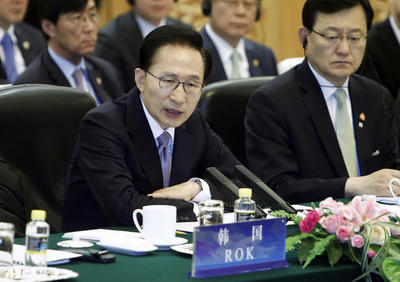One major feature of Northeast Asian regionalism (trilateral cooperation among China, Japan and Korea) is that negotiations for a trilateral FTA or investment agreement are steadily progressing. This is despite respective bilateral relations being strained by persistent historical and territorial disputes.
In other words, economic rationalism, which emphasises economic interdependence as a chief motive for regional integration, is not easily applied to bilateral economic arrangements in Northeast Asia. The political complexity of bilateral relations in Northeast Asia has much to do with this apparent paradox, and is further illustrated by China, Japan and Korea’s signing of bilateral FTAs with nations outside the region, including ASEAN and its individual member countries.
So, for example, though Japan is China’s fourth largest trading partner and China is Japan’s largest trading partner in imports and exports, there has been no strong political initiative in either country to form a bilateral FTA.
The FTA between Japan and Korea started as a symbolic policy in 1998, but the negotiations came to a halt in 2004 when then-prime minister Junichiro Koizumi visited the Yasukuni Shrine, amid strong opposition to Japan’s liberalisation of fishery products and South Korea’s concerns about its trade deficit with Japan. Korea and China, for their part, did not seriously consider a bilateral FTA negotiation until President Lee Myung-bak visited Beijing in January 2012.
In order to safeguard the negotiation’s momentum against the negative impacts of bilateral political tensions, the three nations have taken an incremental, low-profile approach to promoting trilateral economic cooperation. This approach relied on the non-governmental sector to facilitate policy dialogues about the FTA and investment, allowing momentum to grow and eventually involve government officials.
Eighteen ministerial-level meetings have helped institutionalise Northeast Asian regionalism, as well as the establishment of intra-governmental policy networks. Less politically contentious areas like tourism, culture and education were initially chosen for trilateral economic cooperation.
This allowed the three governments to maintain the motivation for trilateral integration during politically difficult times. For instance, even after the September-2010 China–Japan clash over the Senkaku Islands, a vice-minister of the Chinese Commerce Ministry expressed his hope to start negotiations for a trilateral FTA the following year.
China and Japan disagree on whether an FTA or an investment agreement should be completed first, which is a major contentious element in efforts to build Northeast Asian economic regionalism. China was reluctant to advance the investment agreement partly because it contains the national treatment clause, stating that foreign and national companies must be treated equally. Since the investment chapter has been included in all of Japan’s bilateral FTAs, the Chinese clung to the position that a trilateral FTA, which China proposed in 2002, should be established ahead of the investment agreement. While there remained differences in priorities between China and Japan, Korea — which supported Japan’s position as a major investor in China — has been reluctant to resume FTA negotiations with Japan and so is not overly receptive to the trilateral FTA.
The US provides a strong impetus to promote trilateral economic regionalism, breaking this impasse. While negotiations on the US-led Trans-Pacific Partnership Agreement (TPP) were progressing, China pushed more strongly than before for the promotion of a trilateral FTA. Significantly, Japan’s interest in the TPP resulted in a more flexible Chinese stance toward Japan when China accepted a proposal from Tokyo to conclude a trilateral investment agreement first (a framework Beijing previously resisted).
The TPP is generally considered a high-standard trade arrangement suited to the US template for FTAs. Given the size of its market, the US hopes that Japan will enter the agreement in the near future. This would greatly enhance the possibility of the TPP becoming a region-wide FTA.
Meanwhile, China is moving away from its almost exclusive pursuit of an ASEAN+3 regional framework, toward greater interest in ASEAN+6 — Japan’s own preferred arrangement. This is a way for China to promote East Asian regional integration while greatly limiting the US’s regional influence. These concessions help Japan keep its FTA options open in the event it does not gain entry into the TPP.
China has since started negotiating a bilateral FTA with Korea partly as a means of pressuring Japan into approaching the trilateral FTA more seriously. The pressure is created by the prospect of Japanese exports being disadvantaged in the Chinese market, because Korean manufacturing products would enjoy non-tariff status, as happened in the EU and US markets.
Though instrumental in promoting trilateral integration, Japan’s and China’s mutual concessions were not generated through trilateral dialogue but by the US deepening involvement in the Asia Pacific through the TPP — and, given the existence of historical and territorial tensions in Northeast Asia, China, Japan and Korea will continue to rely on this external pressure as a key driver for the development of trilateral integration.
Takashi Terada is Professor of International Relations at Doshisha University and was previously Japan Scholar at the Woodrow Wilson International Center for Scholars and a professor at Waseda University.

